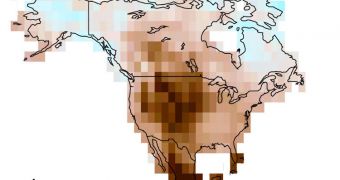A new study funded by the US Department of Energy’s (DOE) Office of Science shows that droughts such as the one currently affecting Texas and Oklahoma will become the norm over the next 40-50 years, and will not appear as out of the ordinary as they do today.
Statistically, the current drought is the worst to affect the region since the time of the Dust Bowl, in the 1930s. Yet, despite the phenomenon being so obviously abnormal today, it will not appear so to the next couple of generations.
There is currently no doubt that the world is warming, yet there seems to be no willingness to do anything about it. Some of the effects of global warming include a rise in the number of droughts and floods affecting certain areas, as well as shift in overall precipitation patterns.
After an in-depth analysis of scenarios produced by 19 different state-of-the-art climate models, experts determined that large regions of North American will continuously experience massive droughts starting around the middle of the 21st century.
The group behind the research was made up of experts from the US National Oceanic and Atmospheric Administration (NOAA), the DOE Lawrence Berkeley National Laboratory (Berkeley Lab) and the DOE Lawrence Livermore National Laboratory (LLNL).
The most important aspect researchers had in mind was the balance between precipitation and evapotranspiration. The latter is a concept referring to how water passes from soils to the atmosphere.
The most significant conclusion the study yielded was that – regardless of precipitation patterns shifts – global warming will lead to an increased incidence of droughts in North America over the next century.
Details of the research were published in the December 2011 issue of the esteemed scientific Journal of Hydrometerology, which is edited by the American Meteorological Society (AMS).
“Drought is a relative condition and in general is characterized by a lack of available water. There are many indices for evaluating drought because different people require information about water availability in different ways,” Michael Wehner says.
“Our results focus on a drought measure that is relevant to soil moisture and is of concern to agricultural and forestry interests. The models project widespread future drought conditions in the United States as the global climate warms over the course of this century,” he adds.
Wehner holds an appointment as a climate scientist with the Berkeley Lab Computational Research Division. He was also the lead author of the journal paper.

 14 DAY TRIAL //
14 DAY TRIAL //